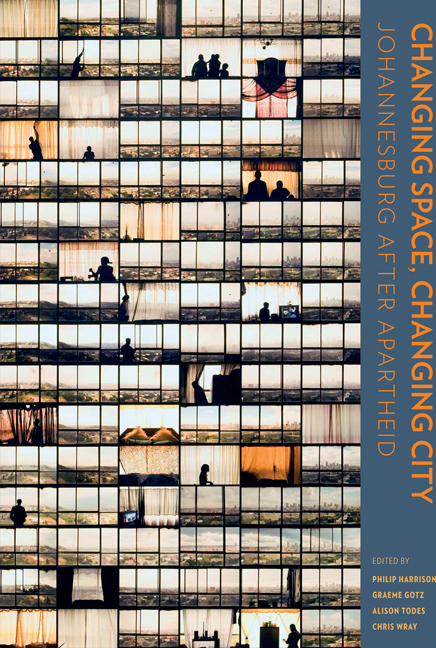Book contents
- Frontmatter
- Contents
- Preface
- Cartography
- 1 Materialities, subjectivities and spatial transformation in Johannesburg
- Section A The macro trends
- Section B Area-based transformations
- 12 Between fixity and flux: Grappling with transience and permanence in the inner city
- 13 Are Johannesburg's peri-central neighbourhoods irremediably ‘fluid’? Local leadership and community building in Yeoville and Bertrams
- 14 The wrong side of the mining belt? Spatial transformations and identities in Johannesburg's southern suburbs
- 15 Soweto: A study in socio-spatial differentiation
- 16 Kliptown: Resilience and despair in the face of a hundred years of planning
- 17 Alexandra
- 18 Sandton Central, 1969–2013: From open veld to new CBD?
- 19 In the forest of transformation: Johannesburg's northern suburbs
- 20 The north-western edge
- 21 The 2010 World Cup and its legacy in the Ellis Park Precinct: Perceptions of local residents
- 22 Transformation through transportation: Some early impacts of Bus Rapid Transit in Orlando, Soweto
- Section C Spatial identities
- Contributors
- Photographic credits
- Acronyms
- List of plates
- List of figures
- List of tables
- Index
19 - In the forest of transformation: Johannesburg's northern suburbs
from Section B - Area-based transformations
Published online by Cambridge University Press: 20 April 2018
- Frontmatter
- Contents
- Preface
- Cartography
- 1 Materialities, subjectivities and spatial transformation in Johannesburg
- Section A The macro trends
- Section B Area-based transformations
- 12 Between fixity and flux: Grappling with transience and permanence in the inner city
- 13 Are Johannesburg's peri-central neighbourhoods irremediably ‘fluid’? Local leadership and community building in Yeoville and Bertrams
- 14 The wrong side of the mining belt? Spatial transformations and identities in Johannesburg's southern suburbs
- 15 Soweto: A study in socio-spatial differentiation
- 16 Kliptown: Resilience and despair in the face of a hundred years of planning
- 17 Alexandra
- 18 Sandton Central, 1969–2013: From open veld to new CBD?
- 19 In the forest of transformation: Johannesburg's northern suburbs
- 20 The north-western edge
- 21 The 2010 World Cup and its legacy in the Ellis Park Precinct: Perceptions of local residents
- 22 Transformation through transportation: Some early impacts of Bus Rapid Transit in Orlando, Soweto
- Section C Spatial identities
- Contributors
- Photographic credits
- Acronyms
- List of plates
- List of figures
- List of tables
- Index
Summary
In this chapter I provide a broad account of the ‘suburbs’ to the north of original Johannesburg. I explore the historical roots of the forms taken by these suburbs and begin an analysis of trajectories of change that are still very much in process. The chapter is based on secondary sources, some primary research, and data available from the city. These suburbs (depending on how defined) cover hundreds of square kilometres and accommodate perhaps a million residents, as well as most of the private investment in the city over the past four decades.
Johannesburg's northern suburbs include areas to the north of the distinct ridge that runs west to east across Florida Hills, Sophiatown, Emmarentia, Westcliff, Parktown, Houghton, Observatory and Linksfield. The distinctive features of the northern suburbs begin here: some of their character is captured in the occasional claim that these areas host ‘the world's largest artificial urban forest’, with literally millions of trees best viewed from the ridges in the Jacaranda flowering season (October–November). These suburbs are known, too, for popular parks around several small ‘lakes’ – Zoo Lake and Emmarentia Dam in particular.
While these suburbs certainly display international or ‘American’ features in relation to house and mall architecture (Guillaume 2001), they are the product of intensely local processes set in global themes. They are as much a ‘product of apartheid’ as the townships; but building an understanding of them requires more than a simple township-suburb dichotomy. The argument I make in this chapter is that the northern suburbs are the result of an exuberant private sector and of particular forms of public action; that they are critical to the economy of the city; and that their global connections and local activities produce tensions likely to become more prominent in the medium term. Analysis indicates that the spatial form of the suburbs presents challenges and opportunities to citizens, local government and businesses; spatial change in recent years may paradoxically have exacerbated these challenges while simultaneously widening the opportunities.
The chapter has five parts, and addresses suburban origins and expansion up to the 1970s; the relationship between apartheid and the suburbs; commercial and business development and changing centralities from 1980 to the turn of the century; a description of changes post-2000 with some explanations; and a concluding consideration of Johannesburg's northern suburbs in relation to the city, the region, South Africa and the wider world.
- Type
- Chapter
- Information
- Changing Space, Changing CityJohannesburg after apartheid, pp. 395 - 417Publisher: Wits University PressPrint publication year: 2014



